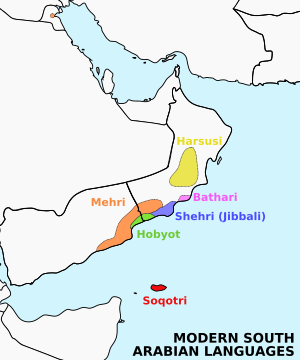用户:H. Sylvanus/索科特拉语
这是草稿:索科特拉语的存档,以防移动/删除多馀草稿时的资料流失。
---
| 索科特拉语 | |
|---|---|
| ماتڸ دسقطري | |
| 发音 | [ˈmɛtalˠ disaˈk’ɔtˤri][1] |
| 母语国家和地区 | 也门索科特拉岛 |
| 族群 | 索科特拉人 |
母语使用人数 | 70,000 (2015年)[2] |
| 语系 | |
| 语言代码 | |
| ISO 639-3 | sqt |
| Glottolog | soqo1240[3] |
 | |
索科特拉语(索科特拉语:ماتڸ دسقطري,罗马化:mɛ́taḷ di-saḳɔ́ṭri;阿拉伯语:اللغة السقطرية,罗马化:al-luḡah al-suquṭriyyah;英语:Soqotri)是闪米特语族南闪米特语语支下的一种语言,与希伯来语、阿拉伯语、阿姆哈拉语同属一个语族。索科特拉语的使用者主要为瓜达富伊海峡上索科特拉岛以及毗邻阿卜德库里与萨姆哈岛的居民,与迈赫拉语、山地语、拜特赫尔语、哈尔苏西语和霍卜约特语合称为现代南阿拉伯半岛语言。
分类
[编辑]索科特拉语常被误认为阿拉伯语的方言,但其实正式分类为亚非语系闪米特语族南闪米特语语支下的一种现代南阿拉伯半岛语言。[4]
音系
[编辑]| 双唇音 | 齿龈音 | 硬腭音 | 软腭音 | 咽音 | 喉音 | |||
|---|---|---|---|---|---|---|---|---|
| 中央 | 边 | |||||||
| 鼻音 | m | n | ||||||
| 塞音 | 清 | t | k | ʔ | ||||
| 浊 | b | d | ɡ | |||||
| 喉壁化 | tˤ | kʼ | ||||||
| 擦音 | 清 | f | s | ɬ | ʃ | x | ħ | h |
| 浊 | z | ʒ | ɣ | ʕ | ||||
| 喉壁化 | sˤ | ɮˤ | ʃˤ | |||||
| 颤音 | r | |||||||
| 近音 | w | l lˠ | j jʰ | |||||
| 前 | 后 | |
|---|---|---|
| 闭 | i | u |
| 半闭 | e ø | o |
| 半开 | ɛ | (ɔ) |
| 开 | a | |
| 鼻化 | ã ẽ | |
^1 /k/与/g/的正常音位分别为[kʲ] and [gʲ].[1]
^2 /d/在词末发[tˤ]。(例:/ˈsɛrɛd/ [ˈsɛrɛtˤ]“一名少年”).[1]
^3 本土的/x/和/ɣ/在中部和东部方言分别与/ħ/和/ʕ/合并,在西部方言则保存下来。/x/与/ɣ/音在中部和东部方言衹出现在阿拉伯语借词,如/ˈxalfe/ “窗”、/ˈɣali/“昂贵”(阿拉伯语为/ɣaːliː/).[1]
^4 /ʕ/在词末发[ˀħ]。(例:/ˈkʼalˠaʕ/ [ˈkʼalˠaˀħ]“他扔了”)[1][ˀħ]亦不时出现在名词和形容词中间,如[ˈmiˀħo]“小肠”的双数为[ˈmiʕi];从此可见,在大部分情况中[ˀħ]为/ʕ/和/h/合并出来的变体,因此上述例子可重新分析为/ˈmiʕho/和/ˈmiʕi/.[1]
^6 /r/有时腭化成[rʲ],如/ˈrabaħ/ [ˈrʲabaħ].[1]
^7 /i/在开音节时,在/tˤ sˤ ʃˤ ɮˤ kʼ lˠ/等喉壁化辅音后发[ɨʲ],在闭音节发[ɨ](例:/ʕaˈlˠiti/ [ʕa'lˠɨʲti]“两只牙齿”、/sˤiˈtˤoʕo/ [sˤɨʲˈtˤoʕo] "她刚才饿", /ˈmasˤil/、[ˈmasˤɨl]“他采集了龙血树的树脂”).[1]
^8 /u/通常发作自由变体[ou],但亦可发[u];[u]在/ʔ/、/ʕ/前后以及/n/后等位置更常见。[1]
^9 /e/没有重音时发[ɨ],有重音时也有时发[ɨ](例:/ʔeˈk’anem/ [ʔɨ'k’anɨm]“我喂”、/ˈsejjod/ ['sɨjjotˤ])[1] After /ɬ ɮˤ j jʰ k g/ it is usually pronounced [i] (/ˈdeker/ ['dekʲir], /ˈjefoɬ/ ['jifoɬ]).[1][e~ɨ] ([a] after /ħ/) is optionally inserted to break initial /CC-/ clusters and mandatorily after initial /CCC-/ clusters (e.g. /ʃbaħ/ [ʃ(e)ˈbaħ] "he stretched", /tħlˠɛf/ [tħaˈlˠɛf] "may she replace").[1]
^10 [ø] is usually a labialized allophone of /e/, typically occurring under stress before a labial (/m b f w/) or emphatic (/tˤ sˤ ʃˤ ɮˤ kʼ lˠ/) consonant if /o/ is present in the following syllable (e.g. /ˈfelˠho/ [ˈfølˠho] "calves", /ˈtebod/ [ˈtøbod] "she lies").[1] It can also appear as an allophone of /o/ after /ɬ ɮˤ j jʰ k g/ (e.g. /gobk/ [gʲøbk] "I suspected", /ˈɬoʔom/ ['ɬøʔom] "he sold") and in the passive form of suffix conjugation from roots IIIw/y (e.g. /beˈnøwe/ "it was built").[1] It does appear to have minimal pairs with /e/ in some verbal patterns, compare /ˈkʼøbor/ "he buried" and /ˈføsˤar/ "he squashed" with /ˈkʼeber/ "they buried" and /ˈfesˤar/ "it got squashed".[5]
^11 [ɔ] could be evaluated as a positional allophone of /o/, appearing usually but not exclusively in the neighborhood of the nasal (e.g. /fɔnɬ/ "breath", /geˈmɔhɔlˠ/ "she-camel"). But there are minimal pairs like /ho/ "I" and /hɔ/ [a form of address].
^12 In the verbal paradigm [a] acts like a positional allophone of /ɛ/ around pharyngeals. But in nouns and adjectives there are minimal pairs (e.g. /bar/ "strength", /bɛr/ "open place", /ˈnɛfaʕ/ "word", /ˈnafaʕ/ "he worked").[1][5]
^13 The nasal vowels only appear in one word each, /ʕãj/ (< /ʕan/) and /kẽj/ (< /ken/) both mean "from him".[1]
参考文献
[编辑]- ^ 1.00 1.01 1.02 1.03 1.04 1.05 1.06 1.07 1.08 1.09 1.10 1.11 1.12 1.13 1.14 1.15 1.16 Huehnergard, John; Pat-El, Na'ama. The Semitic Languages 2nd: 282–288. 2019-01-01. ISBN 9780367731564.
- ^ 索科特拉语于《民族语》的链接(第19版,2016年)
- ^ Hammarström, Harald; Forkel, Robert; Haspelmath, Martin; Bank, Sebastian (编). Soqotri. Glottolog 2.7. Jena: Max Planck Institute for the Science of Human History. 2016.
- ^ Soqotri. Ethnologue. [2017-05-04].
- ^ 5.0 5.1 Kogan, Leonid; Naumkin, Vitaly. The vowels of Soqotri as a phonemic system. Proceedings of the Seminar for Arabian Studies. 2014, 44: 57–79. ISSN 0308-8421.
